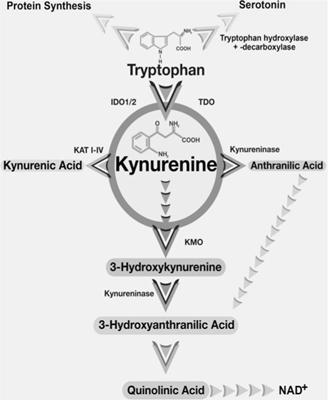Current Topics in Medicinal Chemistry ( IF 3.4 ) Pub Date : 2020-05-31 , DOI: 10.2174/1568026619666190802145128 Alexander Maget 1 , Martina Platzer 1 , Susanne A Bengesser 1 , Frederike T Fellendorf 1 , Armin Birner 1 , Robert Queissner 1 , Carlo Hamm 1 , Bernd Reininghaus 1 , Andrzej Hecker 1 , Lukas Tomberger 1 , Renè Pilz 1 , Nina Dalkner 1 , Natalie Moll 2 , Gregor Schütze 2 , Markus Schwarz 2 , Hans P Kapfhammer 1 , Eva Z Reininghaus 1

|
Background & Objective: The kynurenine pathway is involved in inflammatory diseases. Alterations of this pathway were shown in psychiatric entities as well. The aim of this study was to determine whether specific changes in kynurenine metabolism are associated with current mood symptoms in bipolar disorder.
Methods: Sum scores of the Hamilton Depression Scale, Beck Depression Inventory, and Young Mania Rating Scale were collected from 156 bipolar individuals to build groups of depressive, manic and euthymic subjects according to predefined cut-off scores. Severity of current mood symptoms was correlated with activities of the enzymes kynurenine 3-monooxygenase (ratio of 3-hydroxykynurenine/ kynurenine), kynurenine aminotransferase (ratio of kynurenic acid/ kynurenine) and kynureninase (ratio of 3-hydroxyanthranilic acid/ 3-hydroxykynurenine), proxied by ratios of serum concentrations.
Results: Individuals with manic symptoms showed a shift towards higher kynurenine 3-monooxygenase activity (χ2 = 7.14, Df = 2, p = .028), compared to euthymic as well as depressed individuals. There were no differences between groups regarding activity of kynurenine aminotransferase and kynureninase. Within the group of depressed patients, Hamilton Depression Scale and kynurenine aminotransferase showed a significant negative correlation (r = -0.41, p = .036), displaying lower metabolism in the direction of kynurenic acid.
Discussion: Depression severity in bipolar disorder seems to be associated with a decreased synthesis of putative neuroprotective kynurenic acid. Furthermore, higher kynurenine 3-monooxygenase activity in currently manic individuals indicates an increased inflammatory state within bipolar disorder with more severe inflammation during manic episodes. The underlying pathophysiological mechanisms of the different affective episodes could represent parallel mechanisms rather than opposed processes.
中文翻译:

双相情感障碍的抑郁,躁狂和心律失常阶段中Kynurenine代谢的差异。
背景与目的:犬尿氨酸途径与炎症性疾病有关。这种途径的改变也显示在精神病学实体中。这项研究的目的是确定犬尿氨酸代谢的特定变化是否与双相情感障碍的当前情绪症状有关。
方法:根据预定的临界值,从156位躁郁症患者中收集汉密尔顿抑郁量表,贝克抑郁量表和年轻躁狂症评定量表的总分,以建立抑郁,躁狂和常乐科目组。当前情绪症状的严重程度与犬尿氨酸3-单加氧酶(3-羟基犬尿氨酸/犬尿氨酸之比),犬尿氨酸氨基转移酶(犬尿酸/犬尿氨酸之比)和犬尿氨酸酶(3-羟基邻氨基苯甲酸/ 3-羟基犬尿氨酸之比)的活性相关,以血清浓度的比值表示。
结果:与正常人和抑郁者相比,有躁狂症状的人表现出向犬尿氨酸3-单加氧酶活性更高的转变(χ2= 7.14,Df = 2,p = .028)。组间在犬尿氨酸转氨酶和犬尿氨酸酶的活性方面没有差异。在抑郁症患者组中,汉密尔顿抑郁量表和犬尿氨酸转氨酶显示出显着的负相关性(r = -0.41,p = .036),显示在运动尿酸方向上的新陈代谢较低。
讨论:双相情感障碍的抑郁严重程度似乎与假定的神经保护性犬尿酸合成减少有关。此外,目前躁狂个体中较高的犬尿氨酸3-单加氧酶活性表明躁郁症发作期间双相情感障碍内的炎症状态增加,炎症更为严重。不同情感发作的潜在病理生理机制可能代表平行机制,而不是相反的过程。


























 京公网安备 11010802027423号
京公网安备 11010802027423号